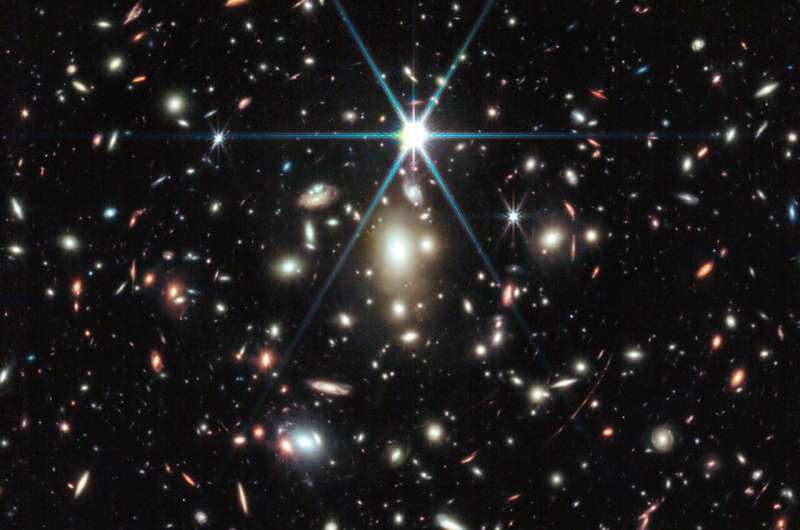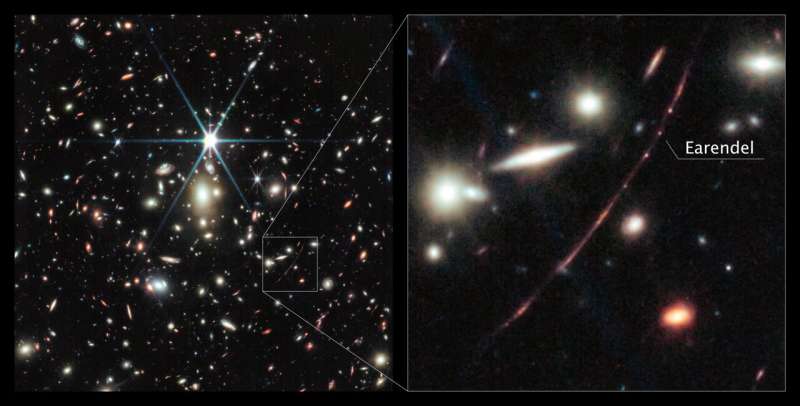This article has been reviewed according to Science X's editorial process and policies. Editors have highlighted the following attributes while ensuring the content's credibility:
fact-checked
peer-reviewed publication
trusted source
proofread
Webb telescope reveals colors of Earendel, most distant star ever detected

Detecting extremely distant stars, or those closest in time to the big bang, can provide insights into the first few chapters of the history of our universe. In 2022, the Hubble Space Telescope broke its own record, and spotted the most distant star yet. This star, nicknamed Earendel, emitted its light within the universe's first billion years.
Spotting, and confirming, the distance of the star is just the beginning, though. That's where NASA's James Webb Space Telescope comes in. Webb's initial observations of Earendel have revealed insights into the star's type, and even the galaxy surrounding the star. Future analysis of Webb spectroscopic observations of Earendel and its host galaxy, the Sunrise Arc, could also reveal information about brightness, temperature, and composition.
NASA's James Webb Space Telescope has followed up on observations by the Hubble Space Telescope of the farthest star ever detected in the very distant universe, within the first billion years after the big bang. Webb's NIRCam (Near-Infrared Camera) instrument reveals the star to be a massive B-type star more than twice as hot as our sun, and about a million times more luminous.
The star, which the research team has dubbed Earendel, is located in the Sunrise Arc galaxy and is detectable only due to the combined power of human technology and nature via an effect called gravitational lensing. Both Hubble and Webb were able to detect Earendel due to its lucky alignment behind a wrinkle in space-time created by the massive galaxy cluster WHL0137-08.
The galaxy cluster, located between us and Earendel, is so massive that it warps the fabric of space itself, which produces a magnifying effect, allowing astronomers to look through the cluster like a magnifying glass.

While other features in the galaxy appear multiple times due to the gravitational lensing, Earendel only appears as a single point of light even in Webb's high-resolution infrared imaging. Based on this, astronomers determine the object is magnified by a factor of at least 4,000, and thus is extremely small—the most distant star ever detected, observed 1 billion years after the big bang.
The previous record-holder for the most distant star was detected by Hubble and observed around 4 billion years after the big bang. Another research team using Webb recently identified a gravitationally lensed star they nicknamed Quyllur, a red giant star observed 3 billion years after the big bang.
Stars as massive as Earendel often have companions. Astronomers did not expect Webb to reveal any companions of Earendel since they would be so close together and indistinguishable on the sky. However, based solely on the colors of Earendel, astronomers think they see hints of a cooler, redder companion star. This light has been stretched by the expansion of the universe to wavelengths longer than Hubble's instruments can detect, and so was only detectable with Webb.
Webb's NIRCam also shows other notable details in the Sunrise Arc, which is the most highly magnified galaxy yet detected in the universe's first billion years. Features include both young star-forming regions and older established star clusters as small as 10 light-years across. On either side of the wrinkle of maximum magnification, which runs right through Earendel, these features are mirrored by the distortion of the gravitational lens.
The region forming stars appears elongated, and is estimated to be less than 5 million years old. Smaller dots on either side of Earendel are two images of one older, more established star cluster, estimated to be at least 10 million years old. Astronomers determined this star cluster is gravitationally bound and likely to persist until the present day. This shows us how the globular clusters in our own Milky Way might have looked when they formed 13 billion years ago.
Astronomers are currently analyzing data from Webb's NIRSpec (Near-Infrared Spectrograph) instrument observations of the Sunrise Arc galaxy and Earendel, which will provide precise composition and distance measurements for the galaxy.
Since Hubble's discovery of Earendel, Webb has detected other very distant stars using this technique, though none quite as far as Earendel. The discoveries have opened a new realm of the universe to stellar physics, and new subject matter to scientists studying the early universe, where once galaxies were the smallest detectable cosmic objects.
The research team has cautious hope that this could be a step toward the eventual detection of one of the very first generation of stars, composed only of the raw ingredients of the universe created in the big bang—hydrogen and helium.
More information: Brian Welch et al, JWST Imaging of Earendel, the Extremely Magnified Star at Redshift z = 6.2, The Astrophysical Journal Letters (2022). DOI: 10.3847/2041-8213/ac9d39
Eros Vanzella et al, JWST/NIRCam Probes Young Star Clusters in the Reionization Era Sunrise Arc, The Astrophysical Journal (2023). DOI: 10.3847/1538-4357/acb59a
Journal information: Astrophysical Journal Letters , Astrophysical Journal
Provided by NASA





















